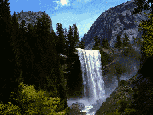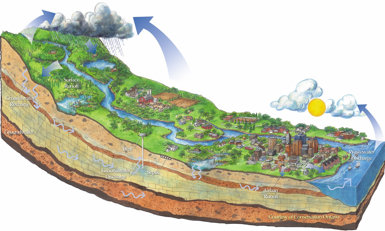 Essay
Essay
return
to previously viewed page
 Water
and Forests are Companions
Water
and Forests are Companions
by J. Siry
Standing on a small ridge of sand my feet sink into white sugar sized granules as if I had been beached on a desert island in the midst of a pygmy forest. I am a giant thing amidst these diminutive trees, but they are themselves surrounded by a tall pine forest. These are trees that thrive on these dry sand hills depending on their proximity to groundwater. Some are pond pine, others are sand pine and others taller and statelier are longleaf pines. Each has come to terms with the sand at my feet the solar radiation falling from the sky, the fungus in their roots and their different tolerances for doing with or without water around their roots.
Thickly surrounded by trees it is hard to envision the connective fabric binding this forest and its apparently dry soil to the water way beneath my feet, the springs below this ridge and the distant creeks that tumble into streams and gush forth eventually as wide meandering rivers. If some have trouble seeing the entire forest through these wooded hills, then we all have even greater difficulty seeing the water inherent in the forests because there is no apparent or obvious relationship.
From this wooded ridge the land falls imperceptibly in relief toward a dry grassland and lower down it converges into a wet prairie that
seasonally spills over into lower wetlands lined with aquatic vegetation. Slowly the accumulating water from this 1000 acre forest seeps under and over ground into a sluggish creek that is joined by percolating groundwater from a small spring gently gushing out along a run until tributary creeks lined by old hardwood swamp trees pour more swiftly along a stream pushing sand into mounds around submerged grasses and fallen snags. The small streams conjoin into rivers because of the relentless flow of the springs and the seasonal runoff of the surface of the ridge. Seasonally and daily rising and falling water passes into a wide river where currents meander between banks of riparian vegetation. A veritable river of lakes and flood plains is created by the combined power of forested and spring fed creeks, runs, streams and brooks which all began beneath the sands of a ridge of forested trees.
So tenuous is this indelible connection among forests, wetlands, springs and rivers that when a watershed is deforested the stream flows fluctuate wildly from nearly dry to torrential flood conditions depending on the duration and acuteness of the rain in the wet season. Leonardo Da Vinci, in studying the Arno River in the 16th century noted how deforestation of the Tuscan hills and created uncontrolled flooding of the river which drained the watershed. The floods destroyed farms and homes in the flood plains and sent mud, silt and debris into the streets of Florence during the winter rainy season.
The toll in human lives and property was seasonably palpable. But it took Da Vinci's imaginative intelligence to see that the rivers have their origins in the well forested or deforested hills of the surrounding countryside.
Woodlands are the source of water, whether we appreciate that or not. But a forest is only one in a chain of causal factors that feed the waters in our streams. These streams that nourish human existence have origins in a set of landscape features that must remain connected, or in their unraveling we also lose our clean, flowing water.
568 words

.gif)



